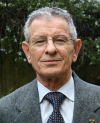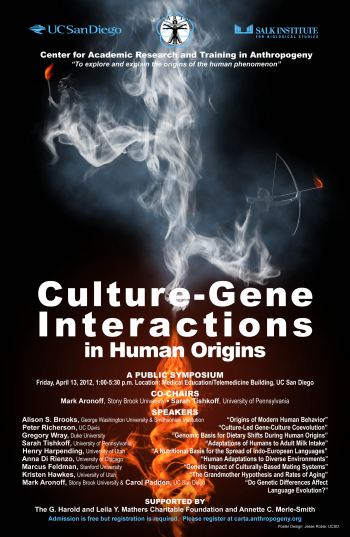Culture-Gene Interactions in Human Origins
Event Date (Pacific Time):
Friday, Apr 13, 2012 - 1:00pm to 5:30pm
Venue:
Event Chairs:
Mark Aronoff, Stony Brook University (State University of New York)
Sarah Tishkoff, University of Pennsylvania, Perelman School of Medicine
Event Speakers:
Abstracts:
Event Sessions:
Media for each talk can be played by clicking on icons in the table below, or by clicking on the individual talk titles below and then the attachment file at the bottom of the page.
| Speakers | Media | Session |
|---|---|---|
 Ajit Varki  Mark Aronoff |
|
Welcome and Opening Remarks |
 Alison Brooks |
|
Origins of Modern Human Behavior What constitutes the essential behavior of our species is contentious. Evolutionary scenarios leading to both the capacity for and practice of these essential behaviors are even more debated. Genetics, cognitive and evolutionary psychology, morphology, reconstructions of climate variation, and the archaeology of human behavior all provide pathways to explore these questions. Furthermore, the newly published genomic studies of our extinct sister species, Neandertals and Denisovans, together with... read more |
 Gregory Wray |
|
Genomic Basis for Dietary Shifts During Human Origins As our australopithecine ancestors moved out of receding rain forests and into drier habitats, they abandoned a primarily fruit-based diet and began consuming more meat and tubers. This increase in consumption protein, fat, and starch coincided in time with important evolutionary changes in cognition and brain size. Genetic and genomic methods are providing insights into the relationship between these two parallel sets of adaptations. Several genes have now been identified that may have... read more |
 Peter Richerson |
|
Culture-led Gene-Culture Coevolution In the classic nature-nurture dichotomy, nature has a stronger or weaker influence on nurture, but certainly nurture was supposed to have no impact on nature. Human culture is often taken to be a form of nurture. However, culture itself has evolutionary properties. In particular, culture generates novel environments that in turn select for novel genes. A few dramatic cases of this effect are well known and many more are suspected. The nature-nurture dichotomy is an impediment to clear thinking... read more |
 Sarah Tishkoff |
|
Adaptations of Humans to Adult Milk Intake In most individuals, the ability to digest lactose, the sugar present in milk, declines rapidly after weaning because of decreasing levels of the enzyme lactase in the small intestine. However, there are individuals who maintain the ability to digest milk into adulthood due to a genetic adaptation in populations that have a history of pastoralism. Here I will discuss our studies of the genetic basis of lactose tolerance in African pastoralist populations. We have identified several mutations... read more |
 Henry Harpending |
|
A Nutritional Basis for the Spread of Indo-European Languages Indo-European languages are native to populations from Ireland to Afghanistan and India and, in historical times, to the Tarim Basin in China. This spread occurred within a few thousand years carried by people who were mostly horse pastoralists and who carried a mutant regulator of the lactase gene so that they could as adults digest milk sugar. Individuals with such lactase persistence are able to extract 40% more calories from milk, while others usually ferment away the milk sugar lactose by... read more |
 Anna Di Rienzo |
|
Human Adaptations to Diverse Environments The history of human evolution and dispersal was associated with remarkable environmental challenges to those processes that maintain stable physiological conditions. Indeed, environmental change over time and over space has been a major feature of human evolution. Though many adaptations undoubtedly occurred at the cultural and behavioral levels, the striking variation of human phenotypes suggests that adaptations also involved genetic changes. Cultural changes, e.g. different modes of... read more |
 Marcus Feldman |
|
Genetic Impact of Culturally-Based Mating Systems For many species, including humans, matings occur among a restricted pool of partners. In humans, restrictions on the choice of partners are culturally determined and frequently are the result of homophily, namely, contacts among individuals that are similar on some dimension. The dimension may itself be culturally transmitted, and its transmission may affect the transmission of other characters, which may be genetically determined, but have nothing to do with the dimension on which the mating... read more |
 Kristen Hawkes |
|
The Grandmother Hypothesis and Rates of Aging A grandmother hypothesis links the evolution of human longevity to ecological changes that left ancestral youngsters unable to get enough food on their own. Help from grandmothers allowed mothers to bear their next baby sooner while setting novel social problems for both mothers and offspring. These connections link grandmothering not only to the evolution of our long lifespans, but also to other features of human life history, physiology, and behavior. Even if only some are correct, they make... read more |
 Carol Padden  Mark Aronoff |
|
Do Genetic Differences Affect Language Evolution? Language is a hallmark of modern humans: only humans have language. Yet, while no human society lacks a language, individual languages exhibit wide variety. In this, language differs greatly from bipedalism, the other hallmark of humans. We explore the question of whether there is a relation between the variety among languages and genetic variation, concentrating on the emergence of sign languages in societies with a high incidence of deafness due to genetic traits. We show that the emergence... read more |
 Mark Aronoff |
|
Question and Answer |
 Mark Aronoff |
|
Closing Remarks |
| Attachment | Size |
|---|---|
| 325.69 KB | |
| 320.81 KB |
If you enjoy this event, please consider supporting CARTA's quest to explore and explain the human phenomenon.


